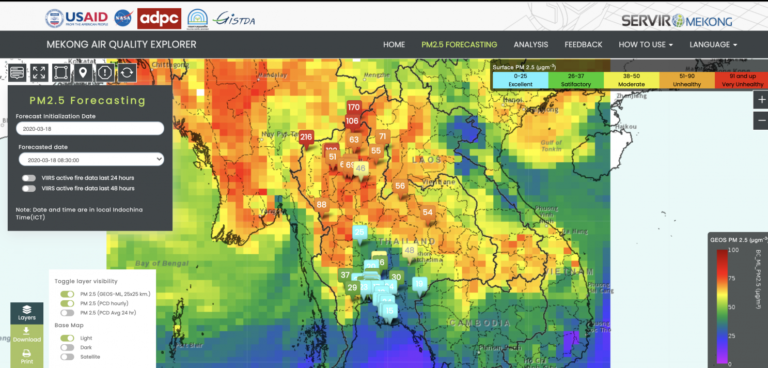Government agencies in Thailand are harnessing the power of NASA’s air quality data and expertise through a partnership with SERVIR, a joint initiative between NASA and the United States Agency for International Development, intended to boost environmental resilience and decision making in developing regions around the world.
Through its network of regional hubs, SERVIR puts publicly available satellite imagery, geospatial data and analysis tools into the hands of local decision makers to help solve their most pressing environmental challenges. The SERVIR-Mekong hub, located at the Asian Disaster Preparedness Center in Bangkok, serves countries in the Mekong River Basin.
To improve air pollution monitoring in Thailand and the lower-Mekong River region, SERVIR-Mekong brought together experts in air quality measurement, technology design, atmospheric modeling and civic engagement. They include the Royal Thai Government’s Pollution Control Department and Geo-Informatics and Space Technology Development Agency–Thailand. Together, they developed a web-based platform for tracking and forecasting air quality in the region.
“Through SERVIR we’re proud to support the Royal Thai Government’s Pollution Control Department in using satellite observations and model outputs to monitor and forecast air quality in Thailand,” explained Lawrence Friedl, director of NASA’s Applied Sciences Program. “Partnerships and collaboration are how we create greater on-the-ground impacts that benefit lives on Earth.”
SERVIR-Mekong’s recently introduced Air Quality Explorer tool features some major advances over past pollution monitoring systems. The new app combines NASA satellite data, ground-sensor data and machine-learning techniques to enable large-scale monitoring and forecasting of air quality for the first time in Thailand. Previous systems relied heavily on ground-based technology.
While sensors on the ground can pinpoint local sources of pollution, satellites have proven essential for filling in missing data to provide consistent, near-real-time maps of pollution hotspots that would otherwise be invisible.
“Poor air quality is a seasonal problem in Thailand that has persisted for over a decade,” noted Steven Olive, mission director of USAID’s Regional Development Mission for Asia. “In addition to providing Thailand with more accurate air pollution readings, this tool also has the potential to address the transboundary challenges that air pollution poses to the region.”
Intense smog resulting in unseasonably poor air quality in early 2019 revealed a need for readily available, reliable and accessible pollution data. Since then, SERVIR-Mekong has put its user-driven development and science expertise to work to improve both monitoring and public awareness. In addition to launching the new tool, the team has held trainings to equip users and even challenged student-innovators to become part of the solution.
Building on the success of the Thai project, SERVIR-Mekong aims to expand the effort to cover other countries that make up the Association of Southeast Asian Nations in the future.



